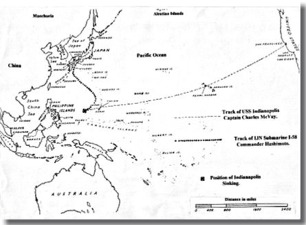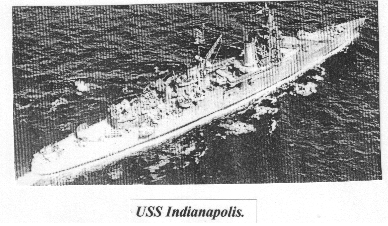|
Indianapolis
Indianapolis, the United States Cruiser, under the command of Captain Charles McVay USN, changed world history, and was instrumental in bringing the war in the Pacific against Japan to its conclusion.
This ship was the transport medium used to transfer the heavy sections of the two Atomic Bombs, from the United States to the Marianas.
A B29, carrying the first Atomic Bomb to be dropped on Hiroshima in Japan, took off from a base in the Marianas.
Japanese Submarine I-58
On the 29th. of July 1945, The Imperial Japanese Navy Submarine I-58, commanded by Lieutenant Commander Hashimoto was on patrol in the vicinity of the intersection of the Leyte/Guam/ Palau/ and Okinawa routes.

At 2308, (11.08 PM) he sighted a blacked out ship, which proved to be Indianapolis, he prepared to fire a six torpedo spread at his target. Hashimoto, with a half moon behind him, and at a range of 1,500 yards, unleashed this salvo, to wait for the running time of his fish to elapse, then to his delight, observe three of his torpedoes strike home.
He took I-58 deep to reload his torpedoes, then, when returning to periscope depth to look at the results of work, he was surprised to see absolutely nothing.
Blair in his book Silent Victory, wrote that Indianapolis was sunk on the 30th. of July by either torpedoes, or by human torpedoes, known as Kaitens, launched from the deck of I-58, but Hashimoto denied he had used Kaitens, much to the chagrin of their crews which he carried on board, and added, all his torpedoes were dispatched before midnight on the 29th. of July 1945.
Hashimoto had been involved in the sneak attack on Pearl Harbour on the 7th. of December 1941, but throughout the war, he had not as much as sunk a single enemy ship. He later recalled that the day after his first success, "We celebrated our haul, with our favourite rice, with beans, boiled eels, and corned beef, all of it, tinned."
Delay in locating survivors from Indianapolis
The report made by I-58 about her sinking Indianapolis, had been read by US authorities, but no credence was given to it, and no action was taken to verify the reported sinking of this United States Navy Cruiser. Back in the Philippines, no one in the Naval Command was aware that Indianapolis had not turned up, as a result, survivors were forced to wait a torturous 84 hours before a lucky sighting of them was made by a routine Navy Patrol Plane.

Many of these survivors were taken by sharks, those continuing to hang on to life by a tenuous thread were desperate for water to drink, and were suffering from the effects of the burning sun by day, and the cold by night.
From a company of 1,199 officers and sailors, only 315, including their Captain were subsequently rescued.
Indianapolis became the last victim of the very nearly extinct Japanese Navy, and the last US ship to be sunk in the war.
On the 14th. of August, the public learned that the ship had been lost in the Philippine Sea as a result of enemy action, and the next of kin had been notified. It so happened, that at the same time, President Harry Truman announced that Japan had surrendered, one can only believe, the timing about the loss of this ship was designed to create the least possible waves.
But family members, and the media began to ask embarassing questions, a scapegoat was sought, and it looked as if Captain Charles Mc Vay was in the box seat.
Court Martial
An inquiry was ordered, it sat for one week, interviewed 43 witnesses, and recommended that McVay face a Court Martial on these charges:
- Culpable inefficiency in the performance of his duty under Article 8, Section 10. Articles for the Government of the Navy.
- Negligently endangering lives of others under Article 22. Articles for the Government of the Navy.
Admiral Nimitz, the Fleet Admiral, did not agree, and ordered the Judge Advocate to address a Letter of Reprimand To Captain McVay in lieu of a Court Martial.
Now, it is most unusual for an order of a Fleet Commander to be countermanded, but on the 25th. of September, the Chief of Naval Operations, Ernest King, wrote to the Secretary of the Navy, saying he disagreed with Nimitz, and recommended that McVay be brought to trial by Court Martial.
It is interesting to note that the record discloses that King, as a junior officer had served with McVay's father, who had reprimanded him, plus public pressure for responsibility for this debacle to be placed some where, and the Secretary for the Navy directed McVay would stand trial. The die was cast, and McVay was selected as the bunny!
The trial was set for the 3rd. of December, and only four days before, the Navy was still struggling to decide what charges to actually bring against Captain McVay.
He was now informed that he would face two charges:
- Through negligence suffering a vessel of the Navy to be hazarded. (The main thrust of this charge was that McVay had failed to cause a zig - zag to be steered, and thus hazarded his command, the United States then being in a state of war.)
- Culpable inefficiency in the performance of his duty. (It was alleged that McVay took too long to order "Abandon Ship," and by his inefficiency, many persons on board perished with the sinking of the ship, the United States then being in a state of war.)
Now, another amazing order was given by Admiral King, he demanded that Lieutenant Commander Iko Hashimoto, the CO of I-58, at the time of this action, be found in Japan, and brought to Washington DC. as a Procecution Witness!!
This was an unprecedented action, never before in Naval History had a Naval Officer (albeit an enemy one) been used as a witness against the Captain of a ship he had sunk.
There seemed little doubt, King was going for a kill.
At this time, I was serving in the area, as a Lieutenant, Royal Australian Navy, in the 8 inch gunned heavy Cruiser, HMAS Shropshire. This ship, as the result of a Winston Churchill initiative, had been gifted to the RAN, by the Royal Navy, to replace a sister ship, HMAS Canberra, sunk alongside the US heavy Cruisers Quincy, Astoria, and Vincennes at the Battle of Savo Island on the 9th. of August 1942. We had lost 84 men, with another 110 wounded, but the USN suffered over 1,000 dead that night, at that stage of the Pacific war, I was a Sub Lieutenant in Canberra, and was the Officer of the Watch (Officer of the Deck in the US Navy) on her bridge.
As a serving Officer of the Permanent Naval Forces of Australia, if my Captain had found himself in similar circumstances to Captain McVay, I would have been devasted and very, very angry. Then to find that a former enemy submarine Captain who had sunk our ship was to be called, to bolster the prosecution case, would have been the last straw.
I believe that Admiral Ernest King made a dreadful mistake in ensuring that McVay was made to face a Court Martial, it was unprecedented in Naval experience, it appeared to be vindictive, and was totally un American.
After 13 working days McVay's ordeal was finally over, the findings were:
Charge 1. Proven. (that is , failure to zig- zag, but then Captain McVay had admitted prior to his trial, that Indianapolis was not zig-zagging at the time of her sinking)
Charge 2. Not Guilty.
The Sentence
To lose 100 numbers in his temporary grade of Captain, and to lose a 100 numbers in his permanment grade of Commander. (This meant he slipped down the Captain's and Commander's list of seniority by 100 places.)
McVay, and his Naval career were ruined.
The Court, in view of McVay's previous outstanding record and the fact that never before had a Commanding Officer who lost his ship by enemy action faced a Court Martial, recommended clemency by the Reviewing Authority.
The Chief of Navy Personnel recommended to the Secretary of the Navy that McVay's sentence be remitted, and that he be returned to duty, but Forrestal did not wish to make a unilateral decision on this case, and asked King for his opinion. Having done the damage, King now concurred with the Chief of Naval Personnel that Captain McVay be restored to duty, having his sentence remitted.
This farce was finally over, but Captain McVay had to live with this stigma imposed upon him, and the general public considered him to be responsible for the loss of Indianapolis.
McVay was appointed Chief of Staff and Aide to the Commandant, Eighth Naval District, and Commander of the Gulf Sea Frontier, in New Orleans. He served there for three years, was then placed on the retired list as a Rear Admiral on the 30th. of June 1949.
In retirement, he lived at Litchfield, in Connecticut, until, on the 6th. of November 1968, McVay finally took his own life, shooting himself in the head using a .38 revolver, his gardener Al Dudley found him on the front lawn, with his faithful Labrador dog beside him.
This sorry episode was almost closed, and the Indianapolis had claimed yet another victim.
Postscript
In October 2000, after years of effort by survivors and their supporters, legislation was passed in Washington and signed by President Clinton expressing the sense of Congress, among other things that Captain Charles McVay record, should now reflect he be exonerated for the loss of USS Indianapolis and for the death of her crew who were lost.
Then in July 2001, the Navy Department announced that Captain McVay's record had been amended to exonerate him for the loss of USS Indianapolis, and the loss of those who perished as a result of her sinking. This action was taken by the Secretary of the Navy, Gordon D. England.
But, this action does not remove the conviction from McVay's record.
Nor would a Presidential pardon, a pardon simply frees an individual from punishment, but it does not clear the conviction nor the stain of guilt from the person's record.
A Presidential order to expunge the conviction from Captain McVay's record and bring final justice to this saga is what survivors and their supporters are still working toward.
|